¿Te interesa realizar un curso online de tècnicas del tejido en telar con Anna Champeney?Si te interesa aprender técnicas de diseño y tejido en telar de bajo lizo online, escríbanos y suscribir a nuestro boletín.
 Contacta con nosotros | Collapse weave book by Ann Richards reviewed by Anna Champeney
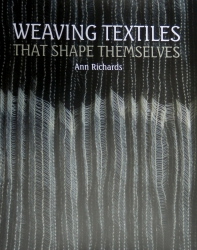 Cover photo Weaving Textiles That Shape Themselves ISBN 978 1 84797 319 1 by The Crowood Press 25 pounds sterling
This collapse weave manual is a comprehensive companion to Lotte Dalgaard´s new Magical Materials To Weave (Trafalgar), also a new publication for 2012. Both authors are experienced, experimental professional weavers with a passion for using active (elastic, overtwisted) yarns. It is a real pleasure to read a book based on serious research, with a wealth of authoritative information, and quality photographs of inspiring woven textiles. A suppliers list, bibliography and cross-referenced index are especially valuable, enabling readers to get the most out of the subject and learn more. Both books understandably focus on the properties of yarn, an understanding of which is fundamental for designing and weaving collapse textiles. Richards´ book is particularly good on explaining about type of spin and the phenomenon of tracking and is comprehensive in its coverage of sett and structure including double weave. Another strength of Richards´ book is her inclusion of stunning work by other prominent weavers worldwide, including Deirdre Wood, Junichi Arai, Reiko Sudo (Nuno). The reversable bag by Junichi Arai (woven in four layers which is completely self-forming) is a good example of the way this Japanese designer relishes technical challenges in weaving. Weaving Textiles That Shape Themselves starts and finishes with the theme of woven textile design. Too often weave books are based on formulas or drafts and cloth swatches which inevitably encourage one to copy rather than innovate. This goes hand-in-hand with another problem in the weaving world which is the lack of opportunitites to learn design skills (I see this in non-English speaking countries like Spain and Latin America, for example). Personally, I was lucky in learning about the importance of sampling from Francisca Pellisca, the Catalan weave artist, who gave me my first introduction to cloth drafting, and so right from the beginning I just assumed that whenever I started a new weave project I would incorporate a section of warp for experimenting, the results of which would lead onto a final, more worked, design. Twelves years on from then and the baskets of samples have become an important reference collection for my own work – it is never enough to have comprehensive written records to refer back to. As Richards comments, this approach of sampling is by no means standard amongst weavers but if the world of constructed textiles is to move on it needs to nurture and promote the idea of weave design as a core skill that all weavers learn – whether as professionals or home weavers. Otherwise standards will drop, the collective body of knowledge will shrink, the sector will lose prestige and visibility and weave be consigned to the status of formula-based hobbycraft rather than as a serious, constantly evolving profession. The chapter “Designing as a Conversation” contains useful pointers for all weavers interested in designing themselves, with straight-forward and practical information, alongside images of Richards´ own work, including her signature pieces – highly sculptural neckpieces. In view of the philosophy behind the book it comes as no surprise that Richards´ book does not contain projects or fabric recipes, but it is clearly aiming at creating a readership that is more interested in acquiring the fundamental knowledge behind collapse weave to empower themselves to develop their own designs. It almost goes without saying that this is not a book for beginners but it is essential reading for those weavers of intermediate to advanced level who are fascinated by the properties of yarn and the incredibly complex interaction with woven structure. This is a book which will inspire and raise standards and should be standard reading on constructed textile courses. Exhibition of collapse textiles in Handweavers´ Studio, London 18 May – 13 June 2012“Minstrel II” Scarf
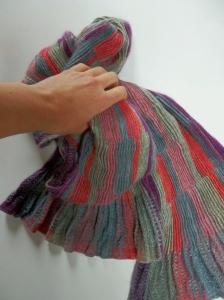 Angora collapse scarf "Minstrel II" by featured artist in exhibition at Handweavers´ Studio 18 May - 13 June 2012
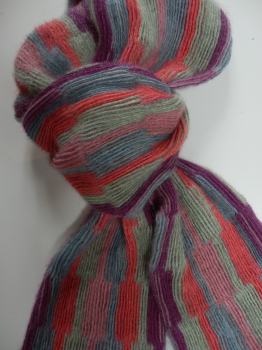 This exhibition features work by Ann Richards and Lotte Dalgaard as well as other artists featured in Weaving Textiles That Shape Themselves. The show isorganised to coincide with the double book launch. This exhibition features work by Ann Richards and Lotte Dalgaard as well as other artists featured in Weaving Textiles That Shape Themselves. The show isorganised to coincide with the double book launch.
Here you can see one of the exhibits, new work by Anna Champeney Estudio Textil, together with interesting background information about how the piece was designed and woven. This piece is available for sale. Price.
- 200cm x 16cm
- Cord weave with reversed weave structure
- Natural dyed angora, alpaca, wool (indigo, copper, cochineal), corneta transparent yarn and high twist wool
Weave Tuition / Weave retreats at Anna Champeney Estudio Textil, SpainAnna Champeney Estudio Textil offers residential weave tuition at the studio itself, set in a picturesque village amidst stunning mountain scenery in northwest Spain (nearest airports: Santiago de Compostela, A Coruña). 8-shaft table looms and yarns (linen, angora, wool) are also available for hire for those wishing to combine a holiday with a weave retreat. Self-catering accommodation is available in Casa dos Artesans, the simple but comfy cottage adjacent to the weave studio (2 – 5 people). The area offers good walking, thermal spas and historic monasteries and castles, plus local bars serving simple, home-cooked fresh food and local wine. To contact the studio directly click here.
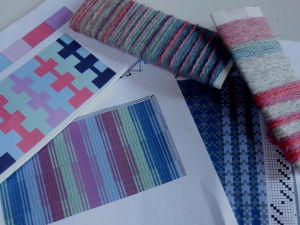 Preliminary design work by Anna Champeney Estudio Textil for Minstrel II includes cloth drafting on Weavepoint, yarn wraps and colour-design tables. The design was based on earlier experiments in cord weave with fairly thick angora, alpaca and wool warp which was hand-dyed with indigo, copper and cochineal. Various samples were woven to test out different effects with different active and stable yarns.
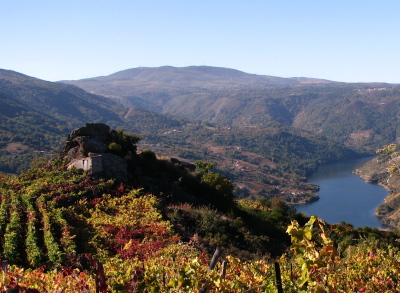 View from the village of Cristosende, where Anna Champeney Estudio Textil is situated in Galicia, northwest Spain
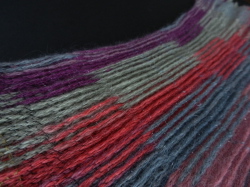 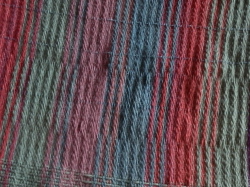 Sampling is an important part of the design process. Different combinations of weft yarns and densities were trialled. In the end the piece used corneta transparent (Danish Yarn Purchasing Association, www.yarn.dk) and a high twist wool in the weft. The second photo shows what the textile design looks like prior to wet finishing, when just cut from the loom.
Just off the loom – Natural dyed silk scarves in waffle weave – available to buy now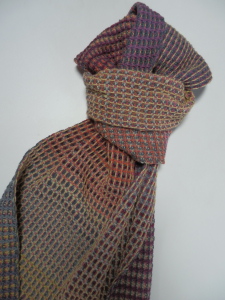 Photo of silk waffle weave scarf by Anna Champeney (ref. 50/50 Laura-F.A.). This special version features numerous colour changes which give it a shimmering effect. This is a non-repeatable, one-of-a-kind piece. SOLD Limited series with unique colourways on each scarf, hand-woven from 50% sillk, 50% wool, with other similar versions with angora, cashmere. Prices range between 95€ – 185€. Information on request.
 original hand-woven fabric design for bag and shoes by Adele Orcajada, textile apprentice at Anna Champeney Estudio Textil (Galicia, Spain)  Adele, you´ve worked in the world of fashion and accessories for quite some time now, so you know this industry well. Tell us a bit about your professional career. Adele, you´ve worked in the world of fashion and accessories for quite some time now, so you know this industry well. Tell us a bit about your professional career.
I was a graphic designer but then did a Masters in accessories´ design. Since then I´ve worked for different types of businesses but all related to fashion. I started in a small craft studio specialising in shoes in Madrid – Franjul. Then I worked for Sfera (clothing brand of the Corte Inglés chain) and Zara and other small companies producing for the luxury market. ¿Typically how many of one particular kind of bag might industry produce for a seasonal collection? It depends on the kind of company. A multinational might produce up to 240,000 of one design in one particular colour, but a high-end luxury brand might produce just 200. ¿What would you say are the hallmarks of a quality bag? A well-made bag has fittings which don´t change or lose their colour, metal zips – where the colour of the zip isn´t lighter than the colour of the leather. If possible it should be exactly the same colour, and this is also true for the colour of the thread used to sew the piece. The lining should never be of polyester! In your opinion can hand-made bags compete with industry? Clients for hand-made bags are different, so I believe industry and craft are not in competition. The person buying a hand-made bag pays more for higher quality and for the distinctive and unique character of the bag, as long as, of course, it is well designed as well as well-made. ¿What are some of the advantages and disadvantes that a craftsperson has compared to industry? The craft maker has a freedom to define their overall design brief and he or she isn´t so limited by fashion trends. The disadvantages include the limited access to raw materials: the minimum orders that suppliers insist on are just too big for small craft producers. ¿What advice or tips can you offer deigner-weavers who want to design their own bags? I´d recommend that they remember that the main feature of the bag is the fabric itself, rather than the bag. Making and designing bags can be a complicated business – it is, after all, a sector in its own right. When a weaver designs a bag they would do well to think of something simple or else seek advice and help from an expert in bag design, or work on a design in collaboration. You´ve been working and training at Anna Champeney Estudio Textil, a small fabric weaving studio in rural northwest Spain this November. Can you tell us a bit about the work you´ve been doing? 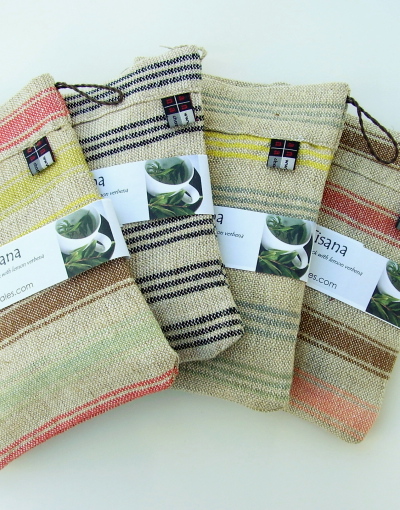
I´ve been helping Anna to make up some of the studio´s products for sale in the shop, and I´ve also learned a lot about the theory necessary for understanding basic weaving design – how to set up a loom, select the fabric structure, select yarns correctly… Then I´ve put all of this into practice in the design and weaving of a final project – in my case – fabric for a bag and matching shoes.  You´re used to living in Madrid, so coming to rural northwest spain has been quite a change for you. What have your impressions been of the village of Cristosende where the textile studio is based, and the surrounding Ribeira Sacra area? You´re used to living in Madrid, so coming to rural northwest spain has been quite a change for you. What have your impressions been of the village of Cristosende where the textile studio is based, and the surrounding Ribeira Sacra area?
It´s a very peaceful area, perfect, in fact, for concentrating on learning to weave. The landscape is also very inspiring, for its colours, textures, and light. What has been the main challenge of learning to weave? Setting up the loom in such a way that the final result is similar to the orginal idea I had in my head. The best part has been being able to improvise once the loom was set up, and just play with all the different possibilities for using colour and texture.
 - Tela para bolso y bailarinas de Adele Orcajada, el proyecto final de su tiempo como aprendiz en el taller textil de tejedora Anna Champeney en Galicia
Visit the Anna Champeney online textile and basket shop – we are now open for christmas Contact us for more
 - Cintia Roberta, fashion student at ESDEMGA, presents her bolero jacket project
The simplest of looms can produce sophisticated and fun results with a bit of imagination and daring, as Spanish Fine Art and Fashion students demonstrated in a recent Creatividad (creativity) workshop aimed at fusing the worlds of fashion and craft. Spanish fashion designer brand American Perez teamed up with profesional weaver and textile artist, Anna Champeney, to lead students in an intensive workshop in which each student had to develop their own methodology, design and realise a weave project from start to finish, in just three days. The workshop reflects the typically innovative approach to fine art and design education adopted by ESDEMGA which focuses on creative and experimental processes. The creative partnerships between profesional Spanish craftspeople and fashion designers were formed to enable students to experience the different approaches taken by each sector to design and making as well as to discover a hands-on, process-based approach to design which encourages a greater sensitivity to textures and fabrics.  - Veronica (ESDEMGA) weaves textural felpa fabric (traditional Galician loop-pile fabri) to create a bag
 - Yeray Suarez combines glorious colours and textures to convert into a belt (ESDEMGA)
 - The traditional fringe loom used by ESDEMGA students to create their textile projects
About the rigid heddle fringe loom Looms similar to this one – measuring about 20 x 8cm – were common in Galicia, north Spain. They were used to weave narrow bands of woven cloth with fringes and tassles which were then sewn onto the heavy, hand-woven folk coverlets as an extra flourish in the overall design. Yarn wrapping and macrame techniques were also applied to the fringes to achieve different effects. The ESDEMGA fashion and art students didn´t confine them to traditional linen and wool yarns, as the folk weavers did, however. The brief, presented by Anna Champeney, at the beginning of the creative workshop, was to develop a metholodogy from scratch, using any and every material and yarn which could be used. As such students used copper wire, wools and linens, strips of recycled cloth, and even 3-d objects and short lengths of willow (more commonly used in basketry not loom weaving) to weave with. Narrow bands of woven fabric were combined and sewn together to make larger scale fabrics or 3-d objects such as bags. Gallery – Creative Craft and Fashion Design Workshop at ESDEMGA (Faculty of Fine Arts in Pontevedra, Galicia) Spain July 2011 Congratulations to all the workshop students who worked so hard during the project: Raquel Álvarez González, Marta González Fortes, Cintia Roberta Cuesta, Maria José Rodríguez Garcia, yeray Suárez Arenas, Pilar Ullod Rivera, Cristina Varela Casal, Maribel, Andrea y Carla. All the pieces in the gallery below were made on the small fringe loom, as in the photo above.
More information: Buy a small fringe loom from AC Estudio Textil for 15,50€ + p&p ESDEMGA website
Linen herb bags – in stock again 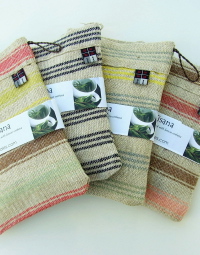 Just to let you know that our traditional Galician linen bags with lemon verbena grown here by us are now in stock again. See the shop for more details. Just to let you know that our traditional Galician linen bags with lemon verbena grown here by us are now in stock again. See the shop for more details.
|
Pago seguro
 NUEVO Octubre 2023 Curso presencial setmanal de teixits de baix lliç (Girona)!Un curso nou, setmanal (3h) a Sant Gregori, Girona, amb l'Anna Champeney. Trimensual, plaças limitadas).
Octobre 2023. Ven a aprender a diseñar y realizar tejidos en telar de bajo lizo a mano. Docente: Anna Champeney, profesional desde 2004, con marca textil propia, experta en tejido de bajo lizo, docente en la Escola Massana, Barcelona.
 Haga clic aquí para informarte |

 Adele, you´ve worked in the world of fashion and accessories for quite some time now, so you know this industry well. Tell us a bit about your professional career.
Adele, you´ve worked in the world of fashion and accessories for quite some time now, so you know this industry well. Tell us a bit about your professional career. 
 You´re used to living in Madrid, so coming to rural northwest spain has been quite a change for you. What have your impressions been of the village of Cristosende where the textile studio is based, and the surrounding Ribeira Sacra area?
You´re used to living in Madrid, so coming to rural northwest spain has been quite a change for you. What have your impressions been of the village of Cristosende where the textile studio is based, and the surrounding Ribeira Sacra area? 












 Just to let you know that our traditional Galician linen bags with lemon verbena grown here by us are now in stock again. See the shop for more details.
Just to let you know that our traditional Galician linen bags with lemon verbena grown here by us are now in stock again. See the shop for more details.



Weaving Textiles That Shape Themselves by Ann Richards – Exhibition and book launch in London May 2012
Collapse weave book by Ann Richards reviewed by Anna Champeney
Cover photo Weaving Textiles That Shape Themselves ISBN 978 1 84797 319 1 by The Crowood Press 25 pounds sterling
This collapse weave manual is a comprehensive companion to Lotte Dalgaard´s new Magical Materials To Weave (Trafalgar), also a new publication for 2012. Both authors are experienced, experimental professional weavers with a passion for using active (elastic, overtwisted) yarns. It is a real pleasure to read a book based on serious research, with a wealth of authoritative information, and quality photographs of inspiring woven textiles. A suppliers list, bibliography and cross-referenced index are especially valuable, enabling readers to get the most out of the subject and learn more. Both books understandably focus on the properties of yarn, an understanding of which is fundamental for designing and weaving collapse textiles. Richards´ book is particularly good on explaining about type of spin and the phenomenon of tracking and is comprehensive in its coverage of sett and structure including double weave. Another strength of Richards´ book is her inclusion of stunning work by other prominent weavers worldwide, including Deirdre Wood, Junichi Arai, Reiko Sudo (Nuno). The reversable bag by Junichi Arai (woven in four layers which is completely self-forming) is a good example of the way this Japanese designer relishes technical challenges in weaving.
Weaving Textiles That Shape Themselves starts and finishes with the theme of woven textile design. Too often weave books are based on formulas or drafts and cloth swatches which inevitably encourage one to copy rather than innovate. This goes hand-in-hand with another problem in the weaving world which is the lack of opportunitites to learn design skills (I see this in non-English speaking countries like Spain and Latin America, for example).
Personally, I was lucky in learning about the importance of sampling from Francisca Pellisca, the Catalan weave artist, who gave me my first introduction to cloth drafting, and so right from the beginning I just assumed that whenever I started a new weave project I would incorporate a section of warp for experimenting, the results of which would lead onto a final, more worked, design. Twelves years on from then and the baskets of samples have become an important reference collection for my own work – it is never enough to have comprehensive written records to refer back to.
As Richards comments, this approach of sampling is by no means standard amongst weavers but if the world of constructed textiles is to move on it needs to nurture and promote the idea of weave design as a core skill that all weavers learn – whether as professionals or home weavers. Otherwise standards will drop, the collective body of knowledge will shrink, the sector will lose prestige and visibility and weave be consigned to the status of formula-based hobbycraft rather than as a serious, constantly evolving profession. The chapter “Designing as a Conversation” contains useful pointers for all weavers interested in designing themselves, with straight-forward and practical information, alongside images of Richards´ own work, including her signature pieces – highly sculptural neckpieces. In view of the philosophy behind the book it comes as no surprise that Richards´ book does not contain projects or fabric recipes, but it is clearly aiming at creating a readership that is more interested in acquiring the fundamental knowledge behind collapse weave to empower themselves to develop their own designs.
It almost goes without saying that this is not a book for beginners but it is essential reading for those weavers of intermediate to advanced level who are fascinated by the properties of yarn and the incredibly complex interaction with woven structure. This is a book which will inspire and raise standards and should be standard reading on constructed textile courses.
Exhibition of collapse textiles in Handweavers´ Studio, London 18 May – 13 June 2012
“Minstrel II” Scarf
Angora collapse scarf "Minstrel II" by featured artist in exhibition at Handweavers´ Studio 18 May - 13 June 2012
Here you can see one of the exhibits, new work by Anna Champeney Estudio Textil, together with interesting background information about how the piece was designed and woven. This piece is available for sale. Price.
Weave Tuition / Weave retreats at Anna Champeney Estudio Textil, Spain
Anna Champeney Estudio Textil offers residential weave tuition at the studio itself, set in a picturesque village amidst stunning mountain scenery in northwest Spain (nearest airports: Santiago de Compostela, A Coruña). 8-shaft table looms and yarns (linen, angora, wool) are also available for hire for those wishing to combine a holiday with a weave retreat. Self-catering accommodation is available in Casa dos Artesans, the simple but comfy cottage adjacent to the weave studio (2 – 5 people). The area offers good walking, thermal spas and historic monasteries and castles, plus local bars serving simple, home-cooked fresh food and local wine. To contact the studio directly click here.
Preliminary design work by Anna Champeney Estudio Textil for Minstrel II includes cloth drafting on Weavepoint, yarn wraps and colour-design tables. The design was based on earlier experiments in cord weave with fairly thick angora, alpaca and wool warp which was hand-dyed with indigo, copper and cochineal. Various samples were woven to test out different effects with different active and stable yarns.
View from the village of Cristosende, where Anna Champeney Estudio Textil is situated in Galicia, northwest Spain
Sampling is an important part of the design process. Different combinations of weft yarns and densities were trialled. In the end the piece used corneta transparent (Danish Yarn Purchasing Association, www.yarn.dk) and a high twist wool in the weft. The second photo shows what the textile design looks like prior to wet finishing, when just cut from the loom.
Just off the loom – Natural dyed silk scarves in waffle weave – available to buy now
Photo of silk waffle weave scarf by Anna Champeney (ref. 50/50 Laura-F.A.). This special version features numerous colour changes which give it a shimmering effect. This is a non-repeatable, one-of-a-kind piece. SOLD
Limited series with unique colourways on each scarf, hand-woven from 50% sillk, 50% wool, with other similar versions with angora, cashmere. Prices range between 95€ – 185€. Information on request.